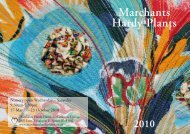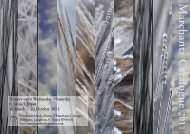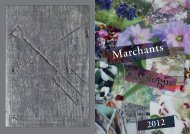download our catalogue free in pdf format here - Marchants Hardy ...
download our catalogue free in pdf format here - Marchants Hardy ...
download our catalogue free in pdf format here - Marchants Hardy ...
Create successful ePaper yourself
Turn your PDF publications into a flip-book with our unique Google optimized e-Paper software.
24<br />
25<br />
POLYPODIUM cambricum ‘Whilharris’. Generally shaggier <strong>in</strong> its appearance, the<br />
lobes of the large 35cm long fronds are also deeply cut, each vaguely resembl<strong>in</strong>g a<br />
small Christmas tree.<br />
P. glycyrrhiza. Bold bi-p<strong>in</strong>natifid fronds whose classic, simple l<strong>in</strong>e could not be<br />
improved upon. The root apparently tastes of liquorice. 45cm.<br />
P. x mantoniae ‘Cornubiense’. A classic fern assumed to be a hybrid. Elegant<br />
bip<strong>in</strong>natifid fronds taper to a f<strong>in</strong>e po<strong>in</strong>t but produces irregular fronds too. Like all<br />
polypodies, needs time to show its true character. 30cm.<br />
*POLYSTICHUM setiferum ‘Herrenhausen’. A robust selection of the soft shield fern<br />
with classic ascend<strong>in</strong>g fronds. Fom the German garden of this name. 70cm.<br />
*P. setiferum ‘Acutilobum’. A sharply etched fern, the 60cm long ladder-like fronds<br />
be<strong>in</strong>g no wider than 80mm. A form of P. setiferum and t<strong>here</strong>fore quite easy.<br />
*P. setiferum ‘Pulcherrimum Bevis’. If time allows, we hope to offer divisions (not<br />
wayward micro-props) of this bl<strong>in</strong>d<strong>in</strong>gly good form of the Soft Shield Fern. Watch<br />
this space and save y<strong>our</strong> money.<br />
POTENTILLA thurberi ‘Monarch’s Velvet’. Deep madder red flowers with a blackmaroon<br />
eye, the size of a ten-penny piece. Ever ga<strong>in</strong><strong>in</strong>g a fan club. 50cm.<br />
P. nepalensis ‘Ron Mc.Beath’. A very brilliant performer branch<strong>in</strong>g from a central<br />
rootsock. The typical c<strong>in</strong>quefoil flowers are not quite red – not quite p<strong>in</strong>k. Seeds with<br />
abandon. 20cm.<br />
PRIMULA ‘Devon Cream’. Blowsy, double cream yellow flower. Very cottagey.<br />
P. auricula ‘Glenelg’. Fancy a green edged fancy? Yellow eye then white, dark red and<br />
lastly green edge. A joy.<br />
P. a. ‘Hetty Wolf’. A subtle show variety with silver grey flowers. Needs mollycoddl<strong>in</strong>g.<br />
10cm.<br />
P. a. ‘Old Mustard’. Deliciously scented, mustard-yellow flowers with a large powdery<br />
white eye. Uncommon. 15cm.<br />
P. a. ‘Old Red Elvet’. A gorgeous old show variety – velvety deep crimson red with a<br />
large mealy white eye. 15cm.<br />
P. a. ‘Slioch’. Surreal grey, black and white flowers and fortunately, not too difficult.<br />
From<br />
£5.35<br />
£5.35<br />
£5.25<br />
£4.75<br />
£4.65<br />
£4.70<br />
£5.00<br />
£5.00<br />
£4.90<br />
£5.00<br />
£5.00<br />
RODGERSIA p. ‘Maurice Mason’. Named by Christopher Lloyd after his plantsman<br />
friend. A magnificent form, handsome <strong>in</strong> foliage, flower (rich p<strong>in</strong>k) and seed (dusky<br />
red) and deserv<strong>in</strong>g of y<strong>our</strong> very best soil. 120cm.<br />
R. podophylla. Ample palmate leaves emerge <strong>in</strong> spr<strong>in</strong>g strik<strong>in</strong>gly bronze flushed,<br />
eventually turn<strong>in</strong>g green but reta<strong>in</strong><strong>in</strong>g their beauty until autumn. 90cm.<br />
R. sambucifolia ‘Mounta<strong>in</strong> Select’. Bold, p<strong>in</strong>nate, textured foliage and taper<strong>in</strong>g,<br />
branched panicles of creamy-white flowers <strong>in</strong> June/July. An uncommon form. 90cm.<br />
ROSCOEA ‘Beesiana’. Related to the G<strong>in</strong>gers these woodland plants have an exotic<br />
beauty. The vaguely orchid like bi-col<strong>our</strong>ed blooms of this form are pale primrose and<br />
reddish-purple. 40cm.<br />
R. cautleoides ‘Kew Beauty’. A tremendously vigorous form with large, primrose<br />
yellow flowers. 45cm.<br />
RUDBECKIA. Stalwarts of the herbaceous border and like wily politicians will go on<br />
and on for years with little enc<strong>our</strong>agement.<br />
*R. fulgida ‘Goldsturm’. The m<strong>in</strong>d boggles as to how Susan received her black eyes.<br />
Perhaps star<strong>in</strong>g at her namesake for too long for this is a bold yellow. In fact, yokes<br />
of <strong>free</strong>-range eggs spr<strong>in</strong>g to m<strong>in</strong>d. Whilst brazen, it rema<strong>in</strong>s a peerless plant. 90 cm.<br />
R. ‘Herbstsonne’. The large bright yellow droop<strong>in</strong>g petals and central green cone make<br />
for a plant of enormous quality. Tangos beautifully with Salvia ulig<strong>in</strong>osa through the<br />
autumn. 2m+.<br />
*R. lac<strong>in</strong>iata. An elegant plant bear<strong>in</strong>g graceful clear yellow daisies with green coned<br />
centres on 2m stems. Both foliage and the persistent seed heads are handsome too.<br />
Big pot size<br />
R. occidentalis ‘Green Wizard’. A curio with a modest tutu of petals <strong>in</strong> apple green,<br />
grossly outsized by its conspicuous large deep chocolate brown cone. A great profile<br />
plant offer<strong>in</strong>g bird fodder too. 90cm.<br />
R. subtomentosa. A notch softer <strong>in</strong> col<strong>our</strong> than some of the former and gentler t<strong>here</strong>fore<br />
on the eye. The central cone resembles a maroon button. Needs a few pea sticks on<br />
<strong>our</strong> w<strong>in</strong>dy site. 120cm.<br />
*R. triloba. A chirpy, late flower<strong>in</strong>g fellow its brassy yellow, black eyed flowers suited<br />
perfectly to the October light. Not long lived buts seeds adequately. 1m+<br />
£7.50<br />
From<br />
£5.50<br />
£6.00<br />
£5.00<br />
£5.25<br />
From<br />
£4.75<br />
PULSATILLA vulgaris rubra. Strong flower<strong>in</strong>g sized plants from <strong>our</strong> very good<br />
burgundy red form. Sun and good dra<strong>in</strong>age. 25cm.<br />
RODGERSIA. It is hard to beat the bold architectural statement a clump of well<br />
grown Rodgersia makes <strong>in</strong> the garden. However, careful attention needs to be paid to<br />
the moisture retentiveness of the soil and <strong>in</strong> the historically drier southeast you may<br />
occasionally need to resort to water<strong>in</strong>g to prevent y<strong>our</strong> plants tak<strong>in</strong>g on the look of<br />
potato crisps.<br />
*R. aesculifolia ‘Die Anmutige’. An Ernst Pagel’s selection chosen for its particularly<br />
richly bronzed foliage and splendid taper<strong>in</strong>g panicles of floaty cream-rose flowers.<br />
1m.<br />
*R. a. ‘Kupfermond’. From Germany and selected for its short stature but does requires<br />
deluxe soil to flower (p<strong>in</strong>k) well. I believe the name means Copper Moon.<br />
*R. p<strong>in</strong>nata ‘Buckland Beauty’. An uncommon form from a Devon garden, selected for<br />
its rufous foliage. Glorious p<strong>in</strong>k flowers <strong>in</strong> high summer. 60cm.<br />
*R. p.‘Cally Salmon’. Strik<strong>in</strong>g spikes of bright salmon p<strong>in</strong>k flowers age<strong>in</strong>g typically to a<br />
weat<strong>here</strong>d red when <strong>in</strong> seed.<br />
£4.50<br />
From<br />
£5.25<br />
£6.00<br />
SALIX eleagnos. The narrow silver-backed leaves of this shapely shrub give it the<br />
appropriate name of ‘Rosemary-leaved Willow’. Given space, it will make a worthy<br />
contribution <strong>in</strong> any not too dry soil and needs little prun<strong>in</strong>g. 3m+<br />
S. purpurea ‘Nancy Saunders’. A remakably elegant form of the purple Osier, its<br />
slender blue-grey leaves add<strong>in</strong>g considerably to the effect. Small grey catk<strong>in</strong>s <strong>in</strong> Feb-<br />
March. 2m+.<br />
SALVIA. Like human be<strong>in</strong>gs, the ubiquitous Sage comes <strong>in</strong> all shapes and sizes, and<br />
also like humans, some are noticeably fussier and more demand<strong>in</strong>g than others. They are<br />
truly worthy plants, giv<strong>in</strong>g us a spread of col<strong>our</strong>ful flowers throughout summer. T<strong>here</strong><br />
should be a plant <strong>here</strong> to suit every taste.<br />
*S. chamelaeagnea. A dist<strong>in</strong>ct and desirable shrubby species from the Cape, South<br />
Africa, the pale violet-blue hooded and ivory lipped flowers suspended on upright<br />
twiggy growth through summer/autumn. Fairly hardy. 80cm.<br />
S. glut<strong>in</strong>osa. Known apparently as ‘Jupiter’s Distaff’, this sticky Sage has large c<strong>our</strong>se<br />
basal leaves, pale yellow flowers and is described <strong>in</strong> one em<strong>in</strong>ent book as ‘Useful for<br />
rough places’. No wonder it does well <strong>in</strong> <strong>our</strong> soil. 1m.<br />
From<br />
£6.00<br />
From<br />
£6.00<br />
£4.75<br />
£4.75





